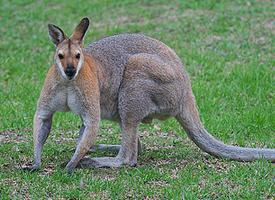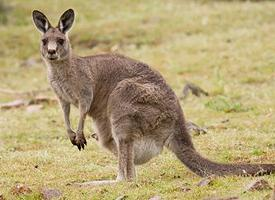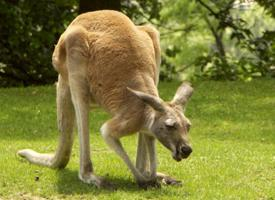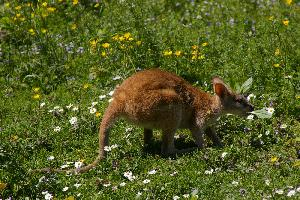
Description de l'animal
The Whiptail wallaby, scientifically known as Notamacropus parryi, is a captivating marsupial native to the eastern regions of Australia, predominantly found in areas ranging from the northern part of Queensland to the southeastern parts of New South Wales. This species, also colloquially referred to as the "Pretty-faced Wallaby" due to its distinctive and appealing facial markings, thrives in a variety of habitats including coastal heaths, forested areas, and grasslands, showcasing its adaptability to different environmental conditions.One of the most striking features of the Whiptail wallaby is its size and physical appearance. Adults can reach lengths of up to 1.8 meters from head to tail, with males generally larger and more robust than females. Their fur is predominantly grey-brown, but what sets them apart is their lighter-colored, almost whitish belly and, most notably, the characteristic "pretty face" - a pattern of lighter fur around the eyes and nose that contrasts with their darker facial markings. This unique facial pattern is thought to play a role in social interactions within their species.
The Whiptail wallaby has a slender build, with long, powerful hind legs designed for bounding at high speeds and making significant leaps, which is a common mode of locomotion among wallabies and kangaroos. Their tail, from which they get their name, is long and thin, acting as a rudder to aid in balance and agility while moving through their environment, whether escaping predators or navigating the complex terrain of their habitat.
Diet-wise, the Whiptail wallaby is herbivorous, feeding on a variety of grasses, leaves, and occasionally roots. Their feeding habits play a crucial role in the ecosystem by aiding in the dispersal of seeds and contributing to the control of vegetation growth.
Socially, the Whiptail wallaby exhibits fascinating behaviors. They are generally solitary or live in small, loosely associated groups known as mobs. These social structures are fluid, with members joining or leaving at will. Communication among Whiptail wallabies involves a series of vocalizations, body postures, and facial expressions, essential for maintaining social bonds and asserting dominance within groups.
Reproduction in the Whiptail wallaby follows the unique reproductive strategy common to many marsupials, known as embryonic diapause. This allows the female to delay the development of an embryo until environmental conditions are favorable, or until the previous joey has vacated the pouch. The gestation period is relatively short, and the underdeveloped joey climbs into the mother's pouch to continue its development, latching onto a teat for nourishment.
Despite their adaptability, Whiptail wallabies face threats from habitat destruction due to agricultural expansion, predation by introduced species such as foxes and feral cats, and collisions with vehicles. Conservation efforts are crucial to ensure the survival of this species, involving habitat protection, research, and monitoring populations to mitigate the impact of threats.
In summary, the Whiptail wallaby (Notamacropus parryi) is an integral part of Australia's biodiversity, characterized by its distinctive appearance, fascinating social structures, and unique reproductive strategies. Their continued survival depends on the concerted efforts of conservationists, policymakers, and the community to protect their natural habitats and address the challenges they face in the wild.
Animaux similaires
Nouvelles photos d'animaux
Top 10 des animaux
- Dolphin gull (Leucophaeus scoresbii)
- Japanese macaque (Macaca fuscata)
- Stone loach (Barbatula barbatula)
- Greek tortoise (Testudo graeca)
- Russian tortoise (Testudo horsfieldii)
- Galápagos tortoise (Geochelone nigra complex)
- Diana monkey (Cercopithecus diana)
- Moustached guenon (Cercopithecus cephus)
- Common flying dragon (Draco volans)
- Galápagos penguin (Spheniscus mendiculus)


